Risk Management and Corporate Governance Analysis: Ardent Leisure Ltd
VerifiedAdded on 2020/02/23
|11
|2611
|144
Report
AI Summary
This report provides a comprehensive analysis of the risk management failures and corporate governance issues at Ardent Leisure Limited, focusing on the Dreamworld accident. The report examines the company's non-compliance with the Australian Securities Exchange (ASX) principles, particularly Principle 7, which addresses the identification and mitigation of risks. It explores the legal consequences, including potential civil penalties and the implications of Section 180 of the Corporations Act 2001, which outlines directors' duties of care and diligence. The analysis also covers the impact of the incident on the company's financial performance, share value, and reputation, including the resignation of the CEO, Deborah Thomas. The report highlights the need for effective risk management frameworks, crisis management teams, and adherence to corporate governance best practices to prevent such incidents and minimize their impact. The report concludes that the board of directors failed to identify and address risks related to the accident and the company suffered significant financial, social, and goodwill losses.
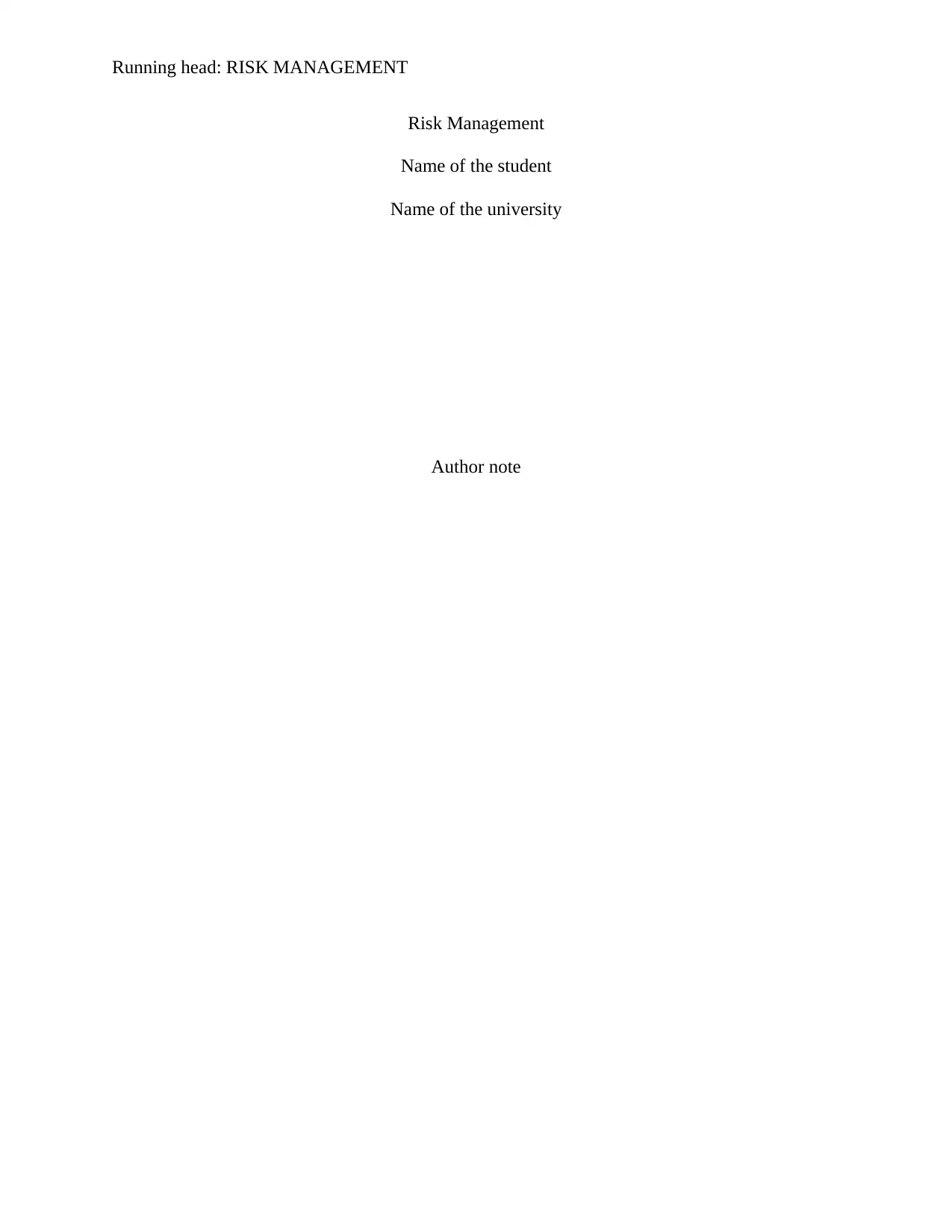
Running head: RISK MANAGEMENT
Risk Management
Name of the student
Name of the university
Author note
Risk Management
Name of the student
Name of the university
Author note
Paraphrase This Document
Need a fresh take? Get an instant paraphrase of this document with our AI Paraphraser
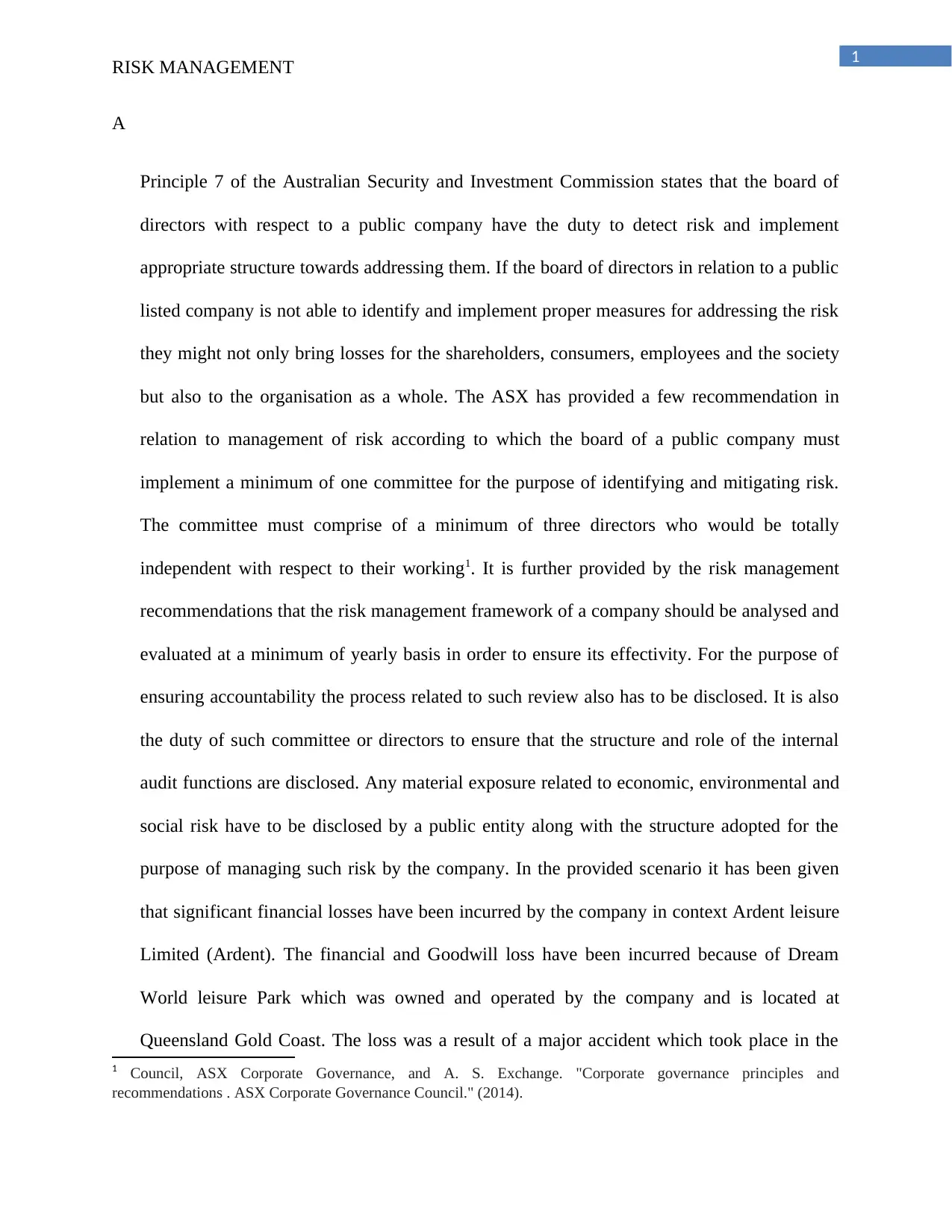
1
RISK MANAGEMENT
A
Principle 7 of the Australian Security and Investment Commission states that the board of
directors with respect to a public company have the duty to detect risk and implement
appropriate structure towards addressing them. If the board of directors in relation to a public
listed company is not able to identify and implement proper measures for addressing the risk
they might not only bring losses for the shareholders, consumers, employees and the society
but also to the organisation as a whole. The ASX has provided a few recommendation in
relation to management of risk according to which the board of a public company must
implement a minimum of one committee for the purpose of identifying and mitigating risk.
The committee must comprise of a minimum of three directors who would be totally
independent with respect to their working1. It is further provided by the risk management
recommendations that the risk management framework of a company should be analysed and
evaluated at a minimum of yearly basis in order to ensure its effectivity. For the purpose of
ensuring accountability the process related to such review also has to be disclosed. It is also
the duty of such committee or directors to ensure that the structure and role of the internal
audit functions are disclosed. Any material exposure related to economic, environmental and
social risk have to be disclosed by a public entity along with the structure adopted for the
purpose of managing such risk by the company. In the provided scenario it has been given
that significant financial losses have been incurred by the company in context Ardent leisure
Limited (Ardent). The financial and Goodwill loss have been incurred because of Dream
World leisure Park which was owned and operated by the company and is located at
Queensland Gold Coast. The loss was a result of a major accident which took place in the
1 Council, ASX Corporate Governance, and A. S. Exchange. "Corporate governance principles and
recommendations . ASX Corporate Governance Council." (2014).
RISK MANAGEMENT
A
Principle 7 of the Australian Security and Investment Commission states that the board of
directors with respect to a public company have the duty to detect risk and implement
appropriate structure towards addressing them. If the board of directors in relation to a public
listed company is not able to identify and implement proper measures for addressing the risk
they might not only bring losses for the shareholders, consumers, employees and the society
but also to the organisation as a whole. The ASX has provided a few recommendation in
relation to management of risk according to which the board of a public company must
implement a minimum of one committee for the purpose of identifying and mitigating risk.
The committee must comprise of a minimum of three directors who would be totally
independent with respect to their working1. It is further provided by the risk management
recommendations that the risk management framework of a company should be analysed and
evaluated at a minimum of yearly basis in order to ensure its effectivity. For the purpose of
ensuring accountability the process related to such review also has to be disclosed. It is also
the duty of such committee or directors to ensure that the structure and role of the internal
audit functions are disclosed. Any material exposure related to economic, environmental and
social risk have to be disclosed by a public entity along with the structure adopted for the
purpose of managing such risk by the company. In the provided scenario it has been given
that significant financial losses have been incurred by the company in context Ardent leisure
Limited (Ardent). The financial and Goodwill loss have been incurred because of Dream
World leisure Park which was owned and operated by the company and is located at
Queensland Gold Coast. The loss was a result of a major accident which took place in the
1 Council, ASX Corporate Governance, and A. S. Exchange. "Corporate governance principles and
recommendations . ASX Corporate Governance Council." (2014).
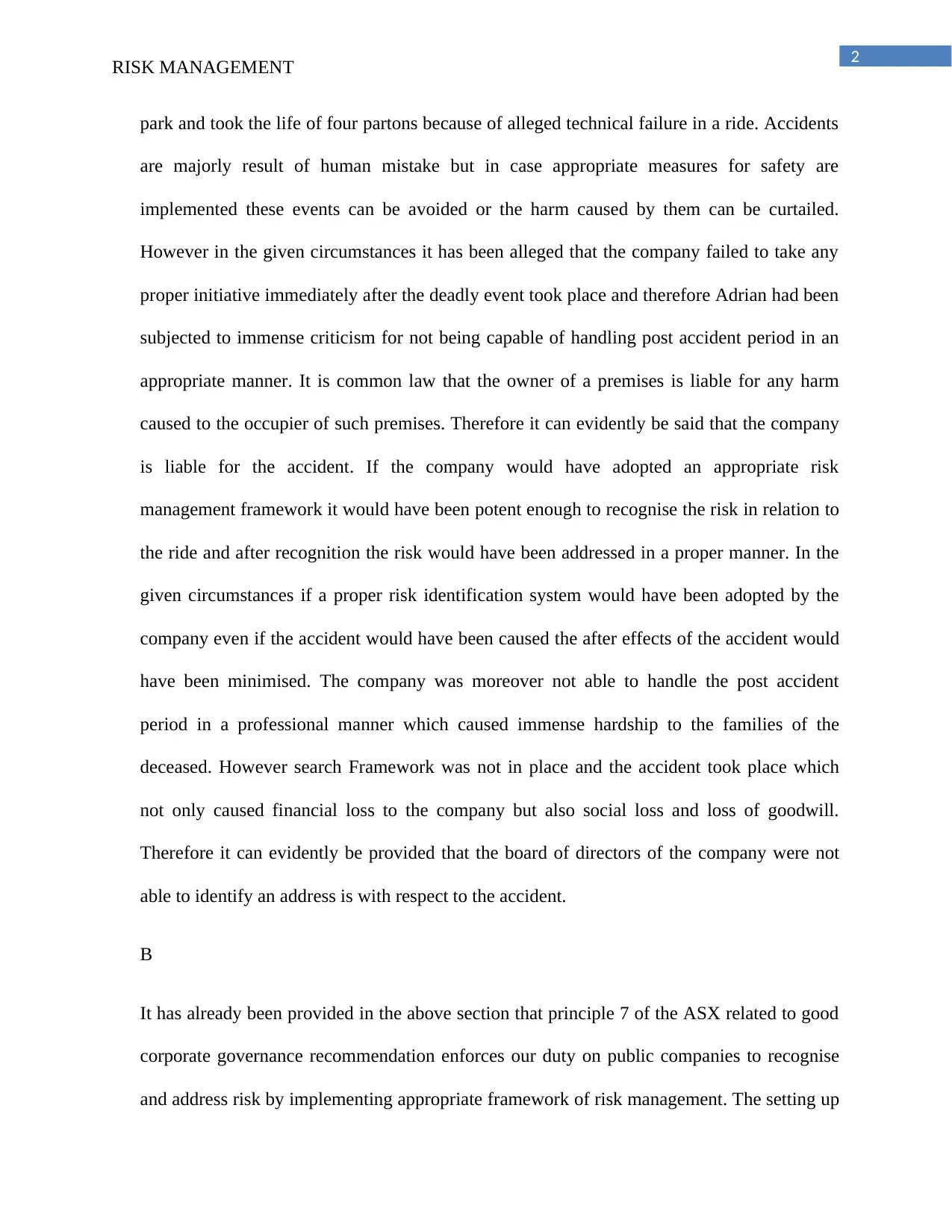
2
RISK MANAGEMENT
park and took the life of four partons because of alleged technical failure in a ride. Accidents
are majorly result of human mistake but in case appropriate measures for safety are
implemented these events can be avoided or the harm caused by them can be curtailed.
However in the given circumstances it has been alleged that the company failed to take any
proper initiative immediately after the deadly event took place and therefore Adrian had been
subjected to immense criticism for not being capable of handling post accident period in an
appropriate manner. It is common law that the owner of a premises is liable for any harm
caused to the occupier of such premises. Therefore it can evidently be said that the company
is liable for the accident. If the company would have adopted an appropriate risk
management framework it would have been potent enough to recognise the risk in relation to
the ride and after recognition the risk would have been addressed in a proper manner. In the
given circumstances if a proper risk identification system would have been adopted by the
company even if the accident would have been caused the after effects of the accident would
have been minimised. The company was moreover not able to handle the post accident
period in a professional manner which caused immense hardship to the families of the
deceased. However search Framework was not in place and the accident took place which
not only caused financial loss to the company but also social loss and loss of goodwill.
Therefore it can evidently be provided that the board of directors of the company were not
able to identify an address is with respect to the accident.
B
It has already been provided in the above section that principle 7 of the ASX related to good
corporate governance recommendation enforces our duty on public companies to recognise
and address risk by implementing appropriate framework of risk management. The setting up
RISK MANAGEMENT
park and took the life of four partons because of alleged technical failure in a ride. Accidents
are majorly result of human mistake but in case appropriate measures for safety are
implemented these events can be avoided or the harm caused by them can be curtailed.
However in the given circumstances it has been alleged that the company failed to take any
proper initiative immediately after the deadly event took place and therefore Adrian had been
subjected to immense criticism for not being capable of handling post accident period in an
appropriate manner. It is common law that the owner of a premises is liable for any harm
caused to the occupier of such premises. Therefore it can evidently be said that the company
is liable for the accident. If the company would have adopted an appropriate risk
management framework it would have been potent enough to recognise the risk in relation to
the ride and after recognition the risk would have been addressed in a proper manner. In the
given circumstances if a proper risk identification system would have been adopted by the
company even if the accident would have been caused the after effects of the accident would
have been minimised. The company was moreover not able to handle the post accident
period in a professional manner which caused immense hardship to the families of the
deceased. However search Framework was not in place and the accident took place which
not only caused financial loss to the company but also social loss and loss of goodwill.
Therefore it can evidently be provided that the board of directors of the company were not
able to identify an address is with respect to the accident.
B
It has already been provided in the above section that principle 7 of the ASX related to good
corporate governance recommendation enforces our duty on public companies to recognise
and address risk by implementing appropriate framework of risk management. The setting up
⊘ This is a preview!⊘
Do you want full access?
Subscribe today to unlock all pages.

Trusted by 1+ million students worldwide
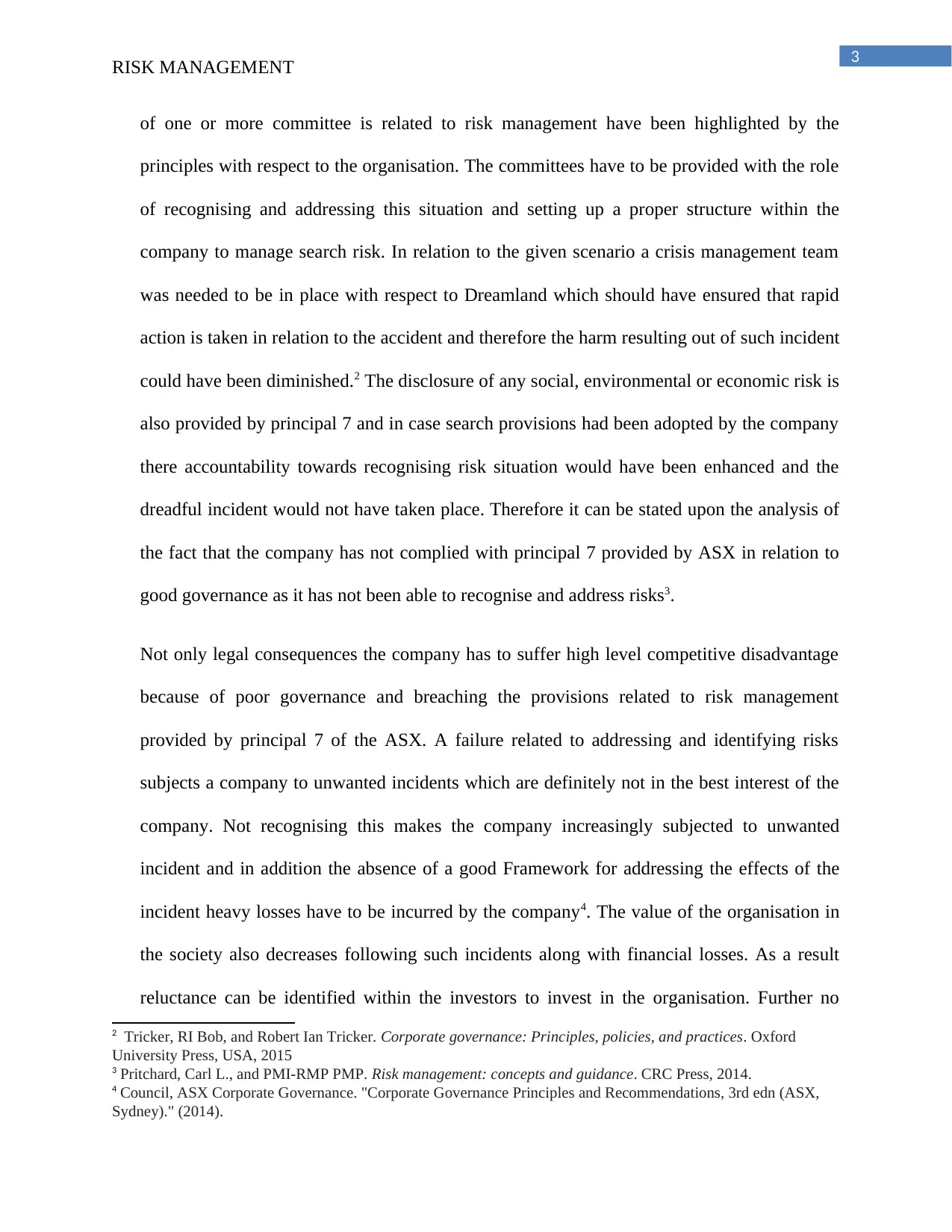
3
RISK MANAGEMENT
of one or more committee is related to risk management have been highlighted by the
principles with respect to the organisation. The committees have to be provided with the role
of recognising and addressing this situation and setting up a proper structure within the
company to manage search risk. In relation to the given scenario a crisis management team
was needed to be in place with respect to Dreamland which should have ensured that rapid
action is taken in relation to the accident and therefore the harm resulting out of such incident
could have been diminished.2 The disclosure of any social, environmental or economic risk is
also provided by principal 7 and in case search provisions had been adopted by the company
there accountability towards recognising risk situation would have been enhanced and the
dreadful incident would not have taken place. Therefore it can be stated upon the analysis of
the fact that the company has not complied with principal 7 provided by ASX in relation to
good governance as it has not been able to recognise and address risks3.
Not only legal consequences the company has to suffer high level competitive disadvantage
because of poor governance and breaching the provisions related to risk management
provided by principal 7 of the ASX. A failure related to addressing and identifying risks
subjects a company to unwanted incidents which are definitely not in the best interest of the
company. Not recognising this makes the company increasingly subjected to unwanted
incident and in addition the absence of a good Framework for addressing the effects of the
incident heavy losses have to be incurred by the company4. The value of the organisation in
the society also decreases following such incidents along with financial losses. As a result
reluctance can be identified within the investors to invest in the organisation. Further no
2 Tricker, RI Bob, and Robert Ian Tricker. Corporate governance: Principles, policies, and practices. Oxford
University Press, USA, 2015
3 Pritchard, Carl L., and PMI-RMP PMP. Risk management: concepts and guidance. CRC Press, 2014.
4 Council, ASX Corporate Governance. "Corporate Governance Principles and Recommendations, 3rd edn (ASX,
Sydney)." (2014).
RISK MANAGEMENT
of one or more committee is related to risk management have been highlighted by the
principles with respect to the organisation. The committees have to be provided with the role
of recognising and addressing this situation and setting up a proper structure within the
company to manage search risk. In relation to the given scenario a crisis management team
was needed to be in place with respect to Dreamland which should have ensured that rapid
action is taken in relation to the accident and therefore the harm resulting out of such incident
could have been diminished.2 The disclosure of any social, environmental or economic risk is
also provided by principal 7 and in case search provisions had been adopted by the company
there accountability towards recognising risk situation would have been enhanced and the
dreadful incident would not have taken place. Therefore it can be stated upon the analysis of
the fact that the company has not complied with principal 7 provided by ASX in relation to
good governance as it has not been able to recognise and address risks3.
Not only legal consequences the company has to suffer high level competitive disadvantage
because of poor governance and breaching the provisions related to risk management
provided by principal 7 of the ASX. A failure related to addressing and identifying risks
subjects a company to unwanted incidents which are definitely not in the best interest of the
company. Not recognising this makes the company increasingly subjected to unwanted
incident and in addition the absence of a good Framework for addressing the effects of the
incident heavy losses have to be incurred by the company4. The value of the organisation in
the society also decreases following such incidents along with financial losses. As a result
reluctance can be identified within the investors to invest in the organisation. Further no
2 Tricker, RI Bob, and Robert Ian Tricker. Corporate governance: Principles, policies, and practices. Oxford
University Press, USA, 2015
3 Pritchard, Carl L., and PMI-RMP PMP. Risk management: concepts and guidance. CRC Press, 2014.
4 Council, ASX Corporate Governance. "Corporate Governance Principles and Recommendations, 3rd edn (ASX,
Sydney)." (2014).
Paraphrase This Document
Need a fresh take? Get an instant paraphrase of this document with our AI Paraphraser
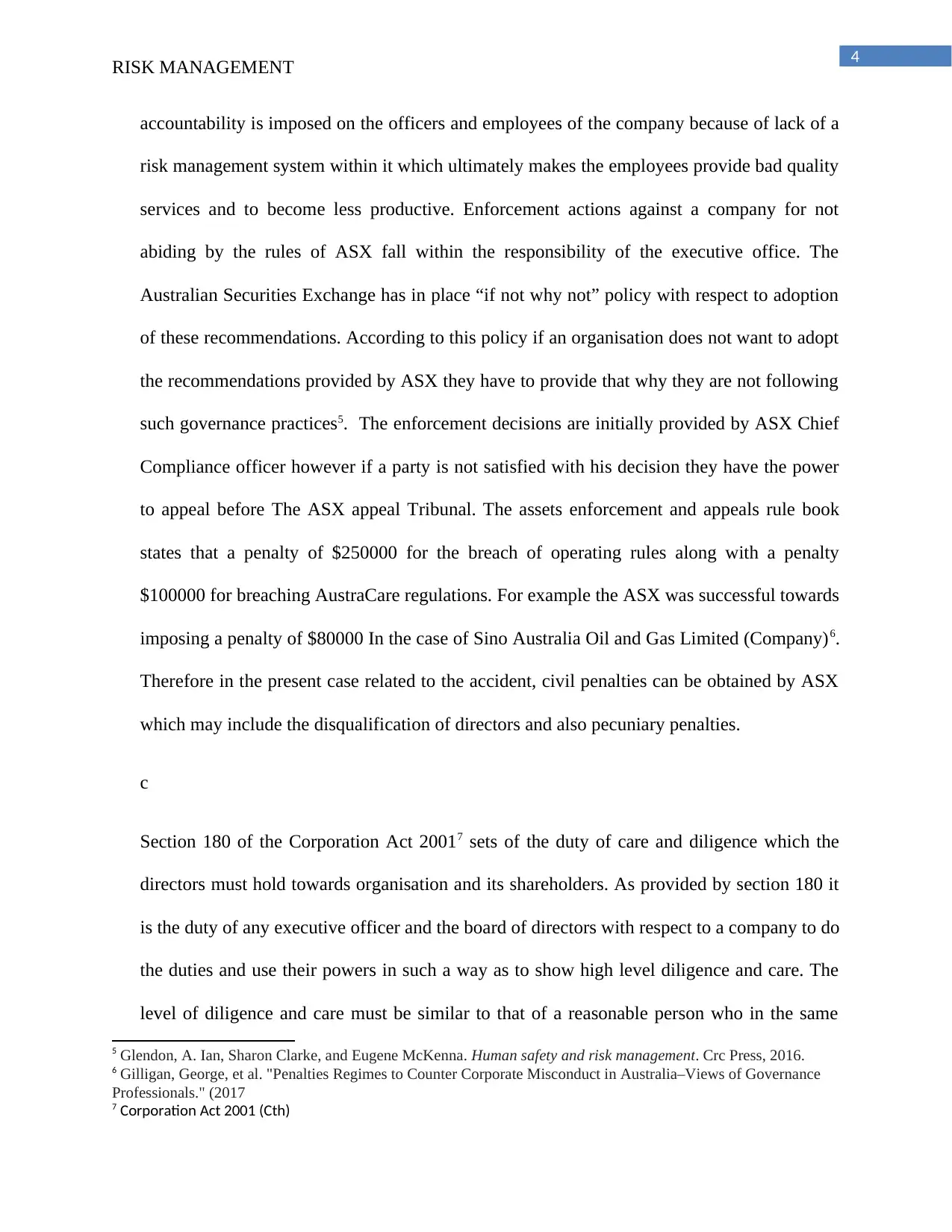
4
RISK MANAGEMENT
accountability is imposed on the officers and employees of the company because of lack of a
risk management system within it which ultimately makes the employees provide bad quality
services and to become less productive. Enforcement actions against a company for not
abiding by the rules of ASX fall within the responsibility of the executive office. The
Australian Securities Exchange has in place “if not why not” policy with respect to adoption
of these recommendations. According to this policy if an organisation does not want to adopt
the recommendations provided by ASX they have to provide that why they are not following
such governance practices5. The enforcement decisions are initially provided by ASX Chief
Compliance officer however if a party is not satisfied with his decision they have the power
to appeal before The ASX appeal Tribunal. The assets enforcement and appeals rule book
states that a penalty of $250000 for the breach of operating rules along with a penalty
$100000 for breaching AustraCare regulations. For example the ASX was successful towards
imposing a penalty of $80000 In the case of Sino Australia Oil and Gas Limited (Company)6.
Therefore in the present case related to the accident, civil penalties can be obtained by ASX
which may include the disqualification of directors and also pecuniary penalties.
c
Section 180 of the Corporation Act 20017 sets of the duty of care and diligence which the
directors must hold towards organisation and its shareholders. As provided by section 180 it
is the duty of any executive officer and the board of directors with respect to a company to do
the duties and use their powers in such a way as to show high level diligence and care. The
level of diligence and care must be similar to that of a reasonable person who in the same
5 Glendon, A. Ian, Sharon Clarke, and Eugene McKenna. Human safety and risk management. Crc Press, 2016.
6 Gilligan, George, et al. "Penalties Regimes to Counter Corporate Misconduct in Australia–Views of Governance
Professionals." (2017
7 Corporation Act 2001 (Cth)
RISK MANAGEMENT
accountability is imposed on the officers and employees of the company because of lack of a
risk management system within it which ultimately makes the employees provide bad quality
services and to become less productive. Enforcement actions against a company for not
abiding by the rules of ASX fall within the responsibility of the executive office. The
Australian Securities Exchange has in place “if not why not” policy with respect to adoption
of these recommendations. According to this policy if an organisation does not want to adopt
the recommendations provided by ASX they have to provide that why they are not following
such governance practices5. The enforcement decisions are initially provided by ASX Chief
Compliance officer however if a party is not satisfied with his decision they have the power
to appeal before The ASX appeal Tribunal. The assets enforcement and appeals rule book
states that a penalty of $250000 for the breach of operating rules along with a penalty
$100000 for breaching AustraCare regulations. For example the ASX was successful towards
imposing a penalty of $80000 In the case of Sino Australia Oil and Gas Limited (Company)6.
Therefore in the present case related to the accident, civil penalties can be obtained by ASX
which may include the disqualification of directors and also pecuniary penalties.
c
Section 180 of the Corporation Act 20017 sets of the duty of care and diligence which the
directors must hold towards organisation and its shareholders. As provided by section 180 it
is the duty of any executive officer and the board of directors with respect to a company to do
the duties and use their powers in such a way as to show high level diligence and care. The
level of diligence and care must be similar to that of a reasonable person who in the same
5 Glendon, A. Ian, Sharon Clarke, and Eugene McKenna. Human safety and risk management. Crc Press, 2016.
6 Gilligan, George, et al. "Penalties Regimes to Counter Corporate Misconduct in Australia–Views of Governance
Professionals." (2017
7 Corporation Act 2001 (Cth)
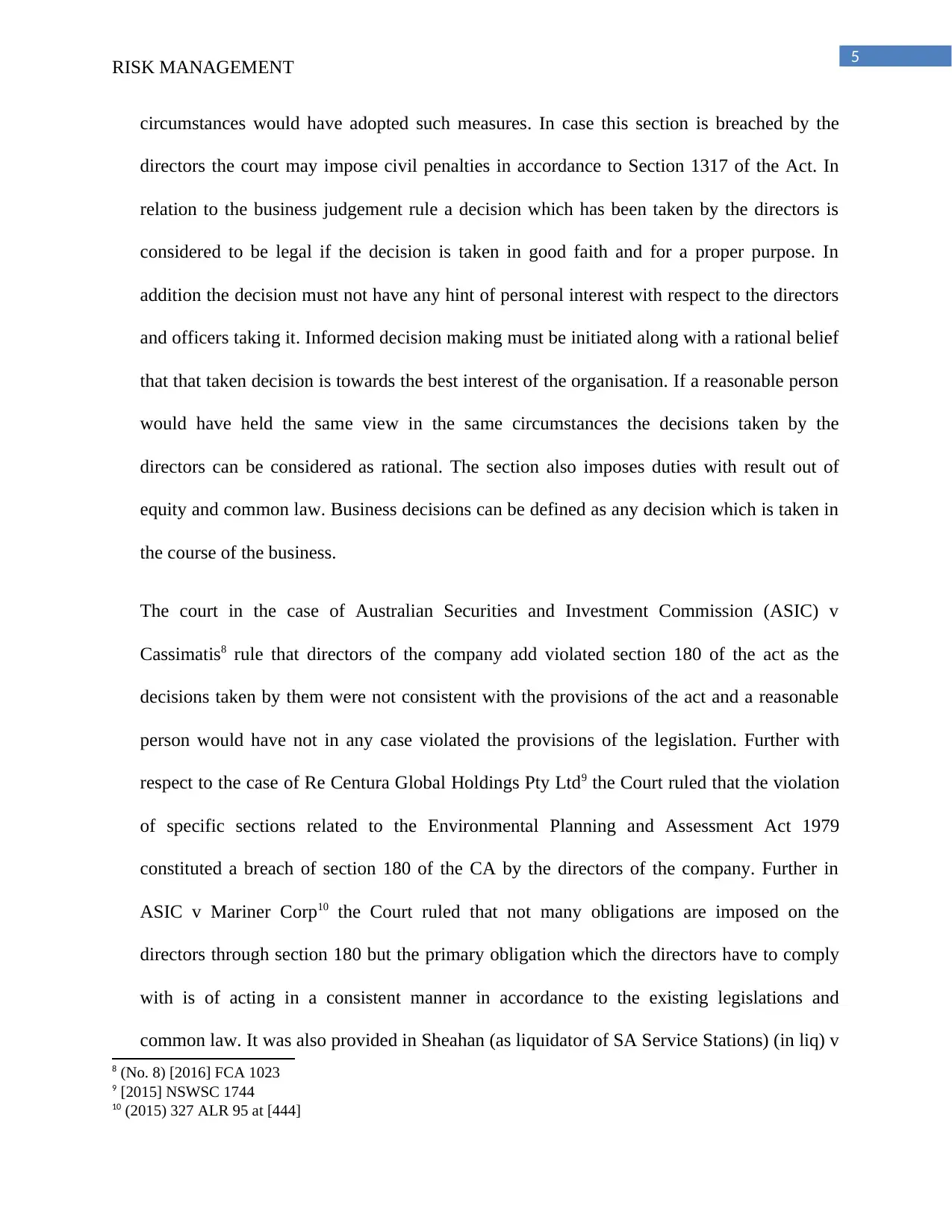
5
RISK MANAGEMENT
circumstances would have adopted such measures. In case this section is breached by the
directors the court may impose civil penalties in accordance to Section 1317 of the Act. In
relation to the business judgement rule a decision which has been taken by the directors is
considered to be legal if the decision is taken in good faith and for a proper purpose. In
addition the decision must not have any hint of personal interest with respect to the directors
and officers taking it. Informed decision making must be initiated along with a rational belief
that that taken decision is towards the best interest of the organisation. If a reasonable person
would have held the same view in the same circumstances the decisions taken by the
directors can be considered as rational. The section also imposes duties with result out of
equity and common law. Business decisions can be defined as any decision which is taken in
the course of the business.
The court in the case of Australian Securities and Investment Commission (ASIC) v
Cassimatis8 rule that directors of the company add violated section 180 of the act as the
decisions taken by them were not consistent with the provisions of the act and a reasonable
person would have not in any case violated the provisions of the legislation. Further with
respect to the case of Re Centura Global Holdings Pty Ltd9 the Court ruled that the violation
of specific sections related to the Environmental Planning and Assessment Act 1979
constituted a breach of section 180 of the CA by the directors of the company. Further in
ASIC v Mariner Corp10 the Court ruled that not many obligations are imposed on the
directors through section 180 but the primary obligation which the directors have to comply
with is of acting in a consistent manner in accordance to the existing legislations and
common law. It was also provided in Sheahan (as liquidator of SA Service Stations) (in liq) v
8 (No. 8) [2016] FCA 1023
9 [2015] NSWSC 1744
10 (2015) 327 ALR 95 at [444]
RISK MANAGEMENT
circumstances would have adopted such measures. In case this section is breached by the
directors the court may impose civil penalties in accordance to Section 1317 of the Act. In
relation to the business judgement rule a decision which has been taken by the directors is
considered to be legal if the decision is taken in good faith and for a proper purpose. In
addition the decision must not have any hint of personal interest with respect to the directors
and officers taking it. Informed decision making must be initiated along with a rational belief
that that taken decision is towards the best interest of the organisation. If a reasonable person
would have held the same view in the same circumstances the decisions taken by the
directors can be considered as rational. The section also imposes duties with result out of
equity and common law. Business decisions can be defined as any decision which is taken in
the course of the business.
The court in the case of Australian Securities and Investment Commission (ASIC) v
Cassimatis8 rule that directors of the company add violated section 180 of the act as the
decisions taken by them were not consistent with the provisions of the act and a reasonable
person would have not in any case violated the provisions of the legislation. Further with
respect to the case of Re Centura Global Holdings Pty Ltd9 the Court ruled that the violation
of specific sections related to the Environmental Planning and Assessment Act 1979
constituted a breach of section 180 of the CA by the directors of the company. Further in
ASIC v Mariner Corp10 the Court ruled that not many obligations are imposed on the
directors through section 180 but the primary obligation which the directors have to comply
with is of acting in a consistent manner in accordance to the existing legislations and
common law. It was also provided in Sheahan (as liquidator of SA Service Stations) (in liq) v
8 (No. 8) [2016] FCA 1023
9 [2015] NSWSC 1744
10 (2015) 327 ALR 95 at [444]
⊘ This is a preview!⊘
Do you want full access?
Subscribe today to unlock all pages.

Trusted by 1+ million students worldwide
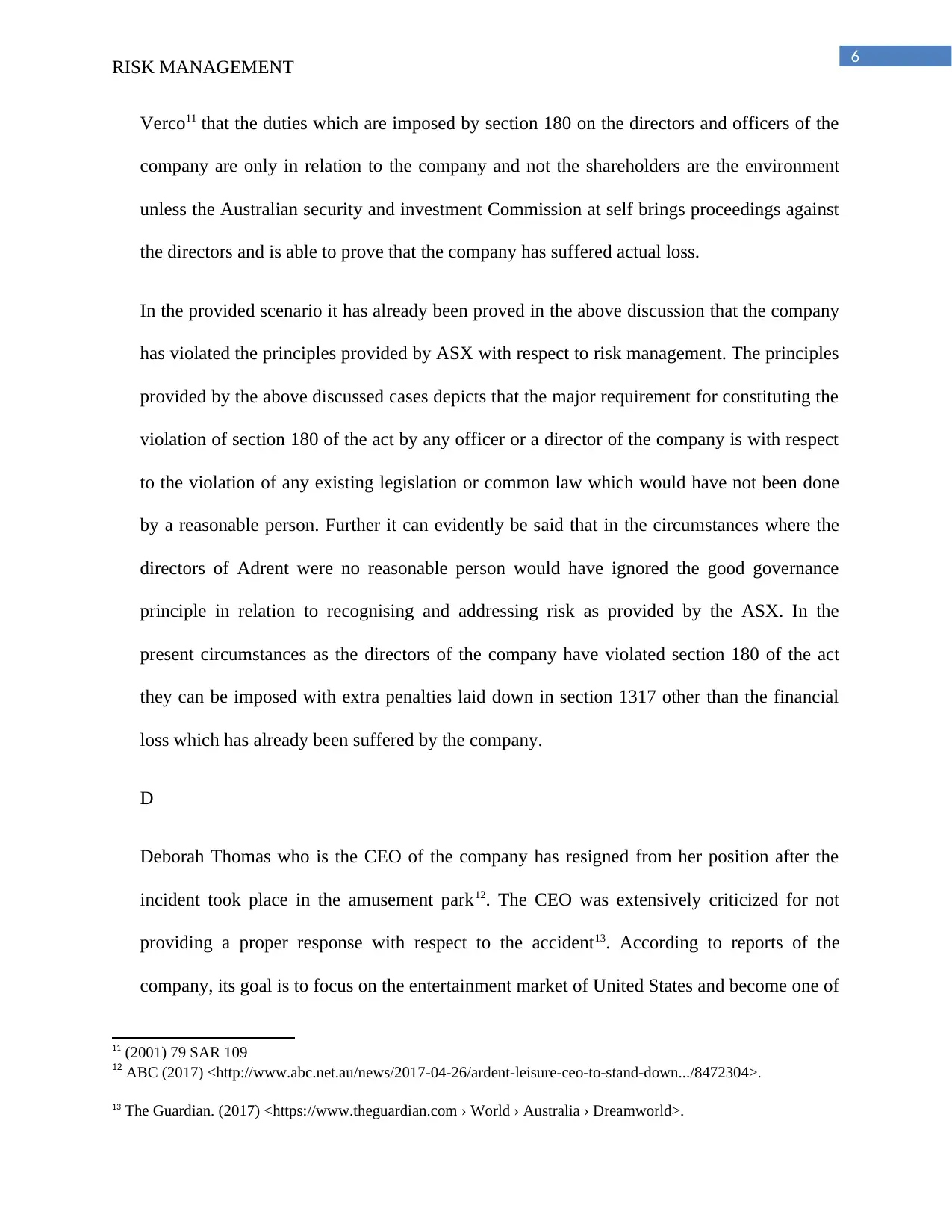
6
RISK MANAGEMENT
Verco11 that the duties which are imposed by section 180 on the directors and officers of the
company are only in relation to the company and not the shareholders are the environment
unless the Australian security and investment Commission at self brings proceedings against
the directors and is able to prove that the company has suffered actual loss.
In the provided scenario it has already been proved in the above discussion that the company
has violated the principles provided by ASX with respect to risk management. The principles
provided by the above discussed cases depicts that the major requirement for constituting the
violation of section 180 of the act by any officer or a director of the company is with respect
to the violation of any existing legislation or common law which would have not been done
by a reasonable person. Further it can evidently be said that in the circumstances where the
directors of Adrent were no reasonable person would have ignored the good governance
principle in relation to recognising and addressing risk as provided by the ASX. In the
present circumstances as the directors of the company have violated section 180 of the act
they can be imposed with extra penalties laid down in section 1317 other than the financial
loss which has already been suffered by the company.
D
Deborah Thomas who is the CEO of the company has resigned from her position after the
incident took place in the amusement park12. The CEO was extensively criticized for not
providing a proper response with respect to the accident13. According to reports of the
company, its goal is to focus on the entertainment market of United States and become one of
11 (2001) 79 SAR 109
12 ABC (2017) <http://www.abc.net.au/news/2017-04-26/ardent-leisure-ceo-to-stand-down.../8472304>.
13 The Guardian. (2017) <https://www.theguardian.com › World › Australia › Dreamworld>.
RISK MANAGEMENT
Verco11 that the duties which are imposed by section 180 on the directors and officers of the
company are only in relation to the company and not the shareholders are the environment
unless the Australian security and investment Commission at self brings proceedings against
the directors and is able to prove that the company has suffered actual loss.
In the provided scenario it has already been proved in the above discussion that the company
has violated the principles provided by ASX with respect to risk management. The principles
provided by the above discussed cases depicts that the major requirement for constituting the
violation of section 180 of the act by any officer or a director of the company is with respect
to the violation of any existing legislation or common law which would have not been done
by a reasonable person. Further it can evidently be said that in the circumstances where the
directors of Adrent were no reasonable person would have ignored the good governance
principle in relation to recognising and addressing risk as provided by the ASX. In the
present circumstances as the directors of the company have violated section 180 of the act
they can be imposed with extra penalties laid down in section 1317 other than the financial
loss which has already been suffered by the company.
D
Deborah Thomas who is the CEO of the company has resigned from her position after the
incident took place in the amusement park12. The CEO was extensively criticized for not
providing a proper response with respect to the accident13. According to reports of the
company, its goal is to focus on the entertainment market of United States and become one of
11 (2001) 79 SAR 109
12 ABC (2017) <http://www.abc.net.au/news/2017-04-26/ardent-leisure-ceo-to-stand-down.../8472304>.
13 The Guardian. (2017) <https://www.theguardian.com › World › Australia › Dreamworld>.
Paraphrase This Document
Need a fresh take? Get an instant paraphrase of this document with our AI Paraphraser
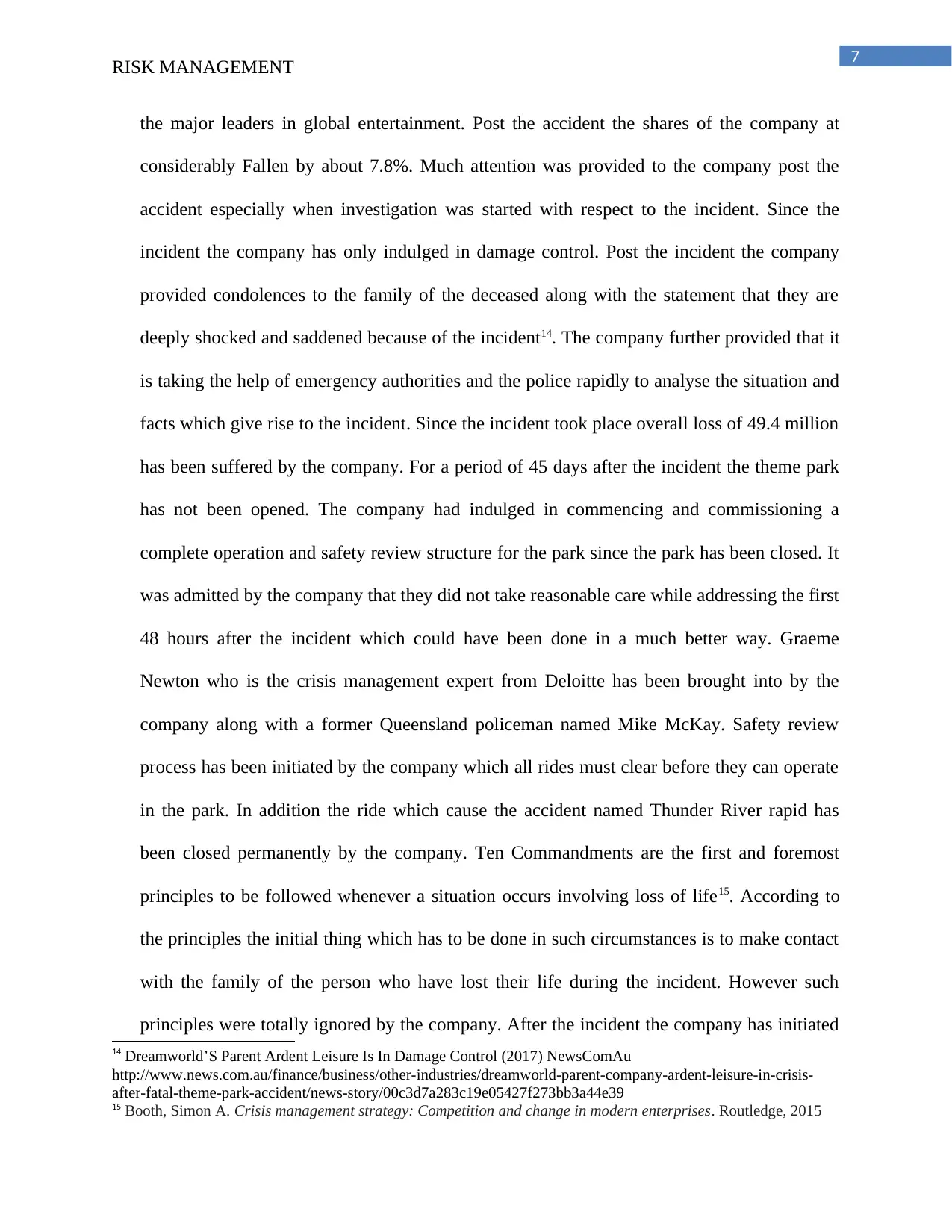
7
RISK MANAGEMENT
the major leaders in global entertainment. Post the accident the shares of the company at
considerably Fallen by about 7.8%. Much attention was provided to the company post the
accident especially when investigation was started with respect to the incident. Since the
incident the company has only indulged in damage control. Post the incident the company
provided condolences to the family of the deceased along with the statement that they are
deeply shocked and saddened because of the incident14. The company further provided that it
is taking the help of emergency authorities and the police rapidly to analyse the situation and
facts which give rise to the incident. Since the incident took place overall loss of 49.4 million
has been suffered by the company. For a period of 45 days after the incident the theme park
has not been opened. The company had indulged in commencing and commissioning a
complete operation and safety review structure for the park since the park has been closed. It
was admitted by the company that they did not take reasonable care while addressing the first
48 hours after the incident which could have been done in a much better way. Graeme
Newton who is the crisis management expert from Deloitte has been brought into by the
company along with a former Queensland policeman named Mike McKay. Safety review
process has been initiated by the company which all rides must clear before they can operate
in the park. In addition the ride which cause the accident named Thunder River rapid has
been closed permanently by the company. Ten Commandments are the first and foremost
principles to be followed whenever a situation occurs involving loss of life15. According to
the principles the initial thing which has to be done in such circumstances is to make contact
with the family of the person who have lost their life during the incident. However such
principles were totally ignored by the company. After the incident the company has initiated
14 Dreamworld’S Parent Ardent Leisure Is In Damage Control (2017) NewsComAu
http://www.news.com.au/finance/business/other-industries/dreamworld-parent-company-ardent-leisure-in-crisis-
after-fatal-theme-park-accident/news-story/00c3d7a283c19e05427f273bb3a44e39
15 Booth, Simon A. Crisis management strategy: Competition and change in modern enterprises. Routledge, 2015
RISK MANAGEMENT
the major leaders in global entertainment. Post the accident the shares of the company at
considerably Fallen by about 7.8%. Much attention was provided to the company post the
accident especially when investigation was started with respect to the incident. Since the
incident the company has only indulged in damage control. Post the incident the company
provided condolences to the family of the deceased along with the statement that they are
deeply shocked and saddened because of the incident14. The company further provided that it
is taking the help of emergency authorities and the police rapidly to analyse the situation and
facts which give rise to the incident. Since the incident took place overall loss of 49.4 million
has been suffered by the company. For a period of 45 days after the incident the theme park
has not been opened. The company had indulged in commencing and commissioning a
complete operation and safety review structure for the park since the park has been closed. It
was admitted by the company that they did not take reasonable care while addressing the first
48 hours after the incident which could have been done in a much better way. Graeme
Newton who is the crisis management expert from Deloitte has been brought into by the
company along with a former Queensland policeman named Mike McKay. Safety review
process has been initiated by the company which all rides must clear before they can operate
in the park. In addition the ride which cause the accident named Thunder River rapid has
been closed permanently by the company. Ten Commandments are the first and foremost
principles to be followed whenever a situation occurs involving loss of life15. According to
the principles the initial thing which has to be done in such circumstances is to make contact
with the family of the person who have lost their life during the incident. However such
principles were totally ignored by the company. After the incident the company has initiated
14 Dreamworld’S Parent Ardent Leisure Is In Damage Control (2017) NewsComAu
http://www.news.com.au/finance/business/other-industries/dreamworld-parent-company-ardent-leisure-in-crisis-
after-fatal-theme-park-accident/news-story/00c3d7a283c19e05427f273bb3a44e39
15 Booth, Simon A. Crisis management strategy: Competition and change in modern enterprises. Routledge, 2015
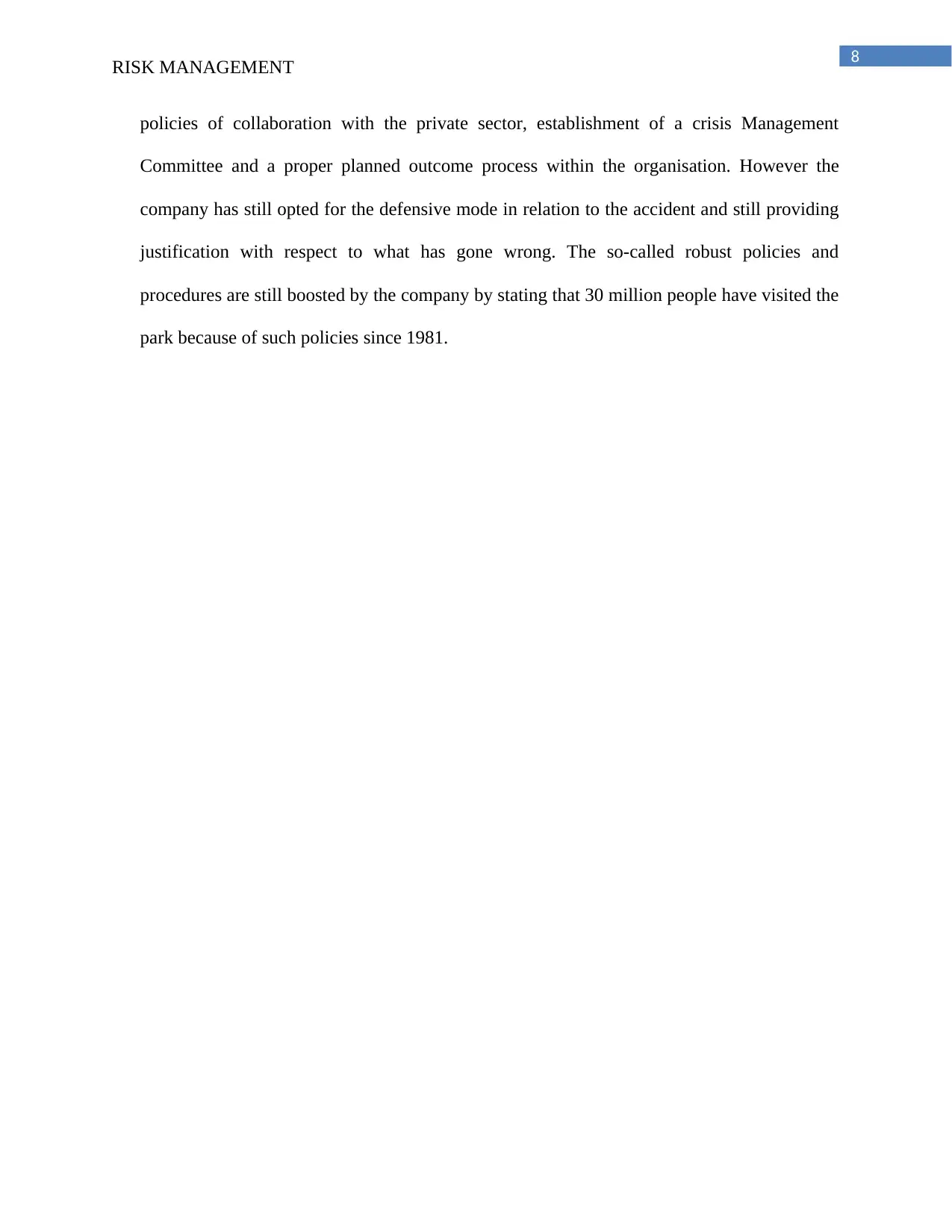
8
RISK MANAGEMENT
policies of collaboration with the private sector, establishment of a crisis Management
Committee and a proper planned outcome process within the organisation. However the
company has still opted for the defensive mode in relation to the accident and still providing
justification with respect to what has gone wrong. The so-called robust policies and
procedures are still boosted by the company by stating that 30 million people have visited the
park because of such policies since 1981.
RISK MANAGEMENT
policies of collaboration with the private sector, establishment of a crisis Management
Committee and a proper planned outcome process within the organisation. However the
company has still opted for the defensive mode in relation to the accident and still providing
justification with respect to what has gone wrong. The so-called robust policies and
procedures are still boosted by the company by stating that 30 million people have visited the
park because of such policies since 1981.
⊘ This is a preview!⊘
Do you want full access?
Subscribe today to unlock all pages.

Trusted by 1+ million students worldwide
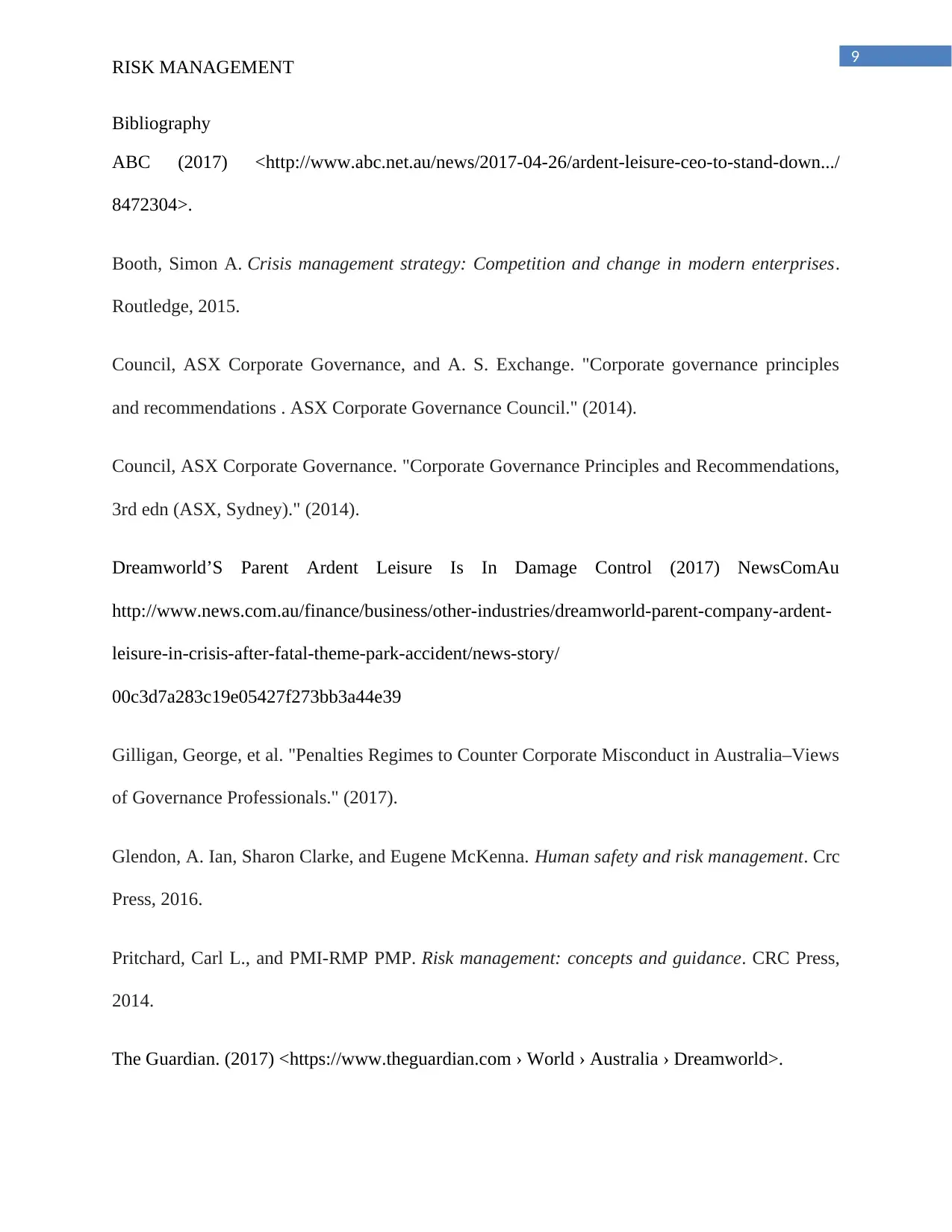
9
RISK MANAGEMENT
Bibliography
ABC (2017) <http://www.abc.net.au/news/2017-04-26/ardent-leisure-ceo-to-stand-down.../
8472304>.
Booth, Simon A. Crisis management strategy: Competition and change in modern enterprises.
Routledge, 2015.
Council, ASX Corporate Governance, and A. S. Exchange. "Corporate governance principles
and recommendations . ASX Corporate Governance Council." (2014).
Council, ASX Corporate Governance. "Corporate Governance Principles and Recommendations,
3rd edn (ASX, Sydney)." (2014).
Dreamworld’S Parent Ardent Leisure Is In Damage Control (2017) NewsComAu
http://www.news.com.au/finance/business/other-industries/dreamworld-parent-company-ardent-
leisure-in-crisis-after-fatal-theme-park-accident/news-story/
00c3d7a283c19e05427f273bb3a44e39
Gilligan, George, et al. "Penalties Regimes to Counter Corporate Misconduct in Australia–Views
of Governance Professionals." (2017).
Glendon, A. Ian, Sharon Clarke, and Eugene McKenna. Human safety and risk management. Crc
Press, 2016.
Pritchard, Carl L., and PMI-RMP PMP. Risk management: concepts and guidance. CRC Press,
2014.
The Guardian. (2017) <https://www.theguardian.com › World › Australia › Dreamworld>.
RISK MANAGEMENT
Bibliography
ABC (2017) <http://www.abc.net.au/news/2017-04-26/ardent-leisure-ceo-to-stand-down.../
8472304>.
Booth, Simon A. Crisis management strategy: Competition and change in modern enterprises.
Routledge, 2015.
Council, ASX Corporate Governance, and A. S. Exchange. "Corporate governance principles
and recommendations . ASX Corporate Governance Council." (2014).
Council, ASX Corporate Governance. "Corporate Governance Principles and Recommendations,
3rd edn (ASX, Sydney)." (2014).
Dreamworld’S Parent Ardent Leisure Is In Damage Control (2017) NewsComAu
http://www.news.com.au/finance/business/other-industries/dreamworld-parent-company-ardent-
leisure-in-crisis-after-fatal-theme-park-accident/news-story/
00c3d7a283c19e05427f273bb3a44e39
Gilligan, George, et al. "Penalties Regimes to Counter Corporate Misconduct in Australia–Views
of Governance Professionals." (2017).
Glendon, A. Ian, Sharon Clarke, and Eugene McKenna. Human safety and risk management. Crc
Press, 2016.
Pritchard, Carl L., and PMI-RMP PMP. Risk management: concepts and guidance. CRC Press,
2014.
The Guardian. (2017) <https://www.theguardian.com › World › Australia › Dreamworld>.
Paraphrase This Document
Need a fresh take? Get an instant paraphrase of this document with our AI Paraphraser
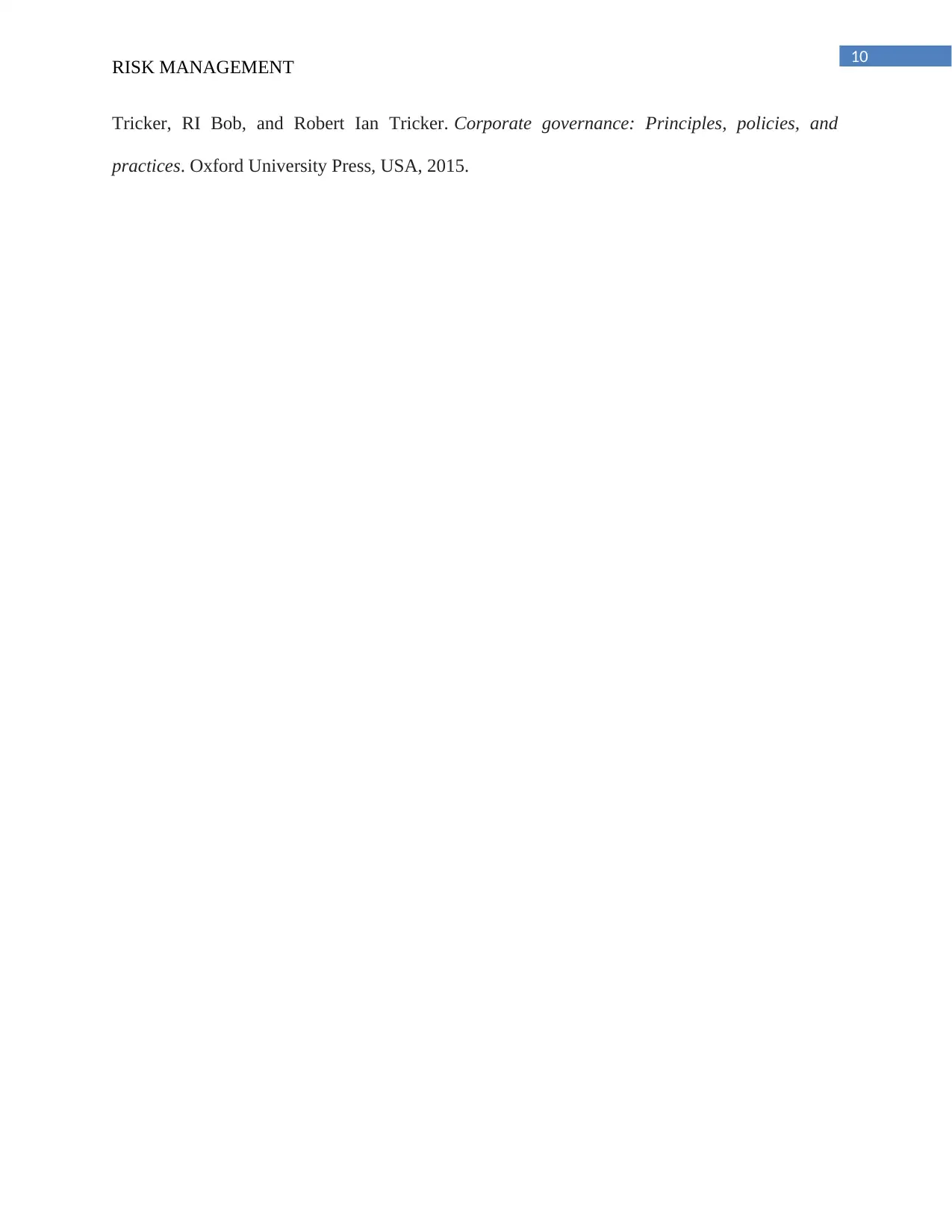
10
RISK MANAGEMENT
Tricker, RI Bob, and Robert Ian Tricker. Corporate governance: Principles, policies, and
practices. Oxford University Press, USA, 2015.
RISK MANAGEMENT
Tricker, RI Bob, and Robert Ian Tricker. Corporate governance: Principles, policies, and
practices. Oxford University Press, USA, 2015.
1 out of 11
Related Documents
Your All-in-One AI-Powered Toolkit for Academic Success.
+13062052269
info@desklib.com
Available 24*7 on WhatsApp / Email
![[object Object]](/_next/static/media/star-bottom.7253800d.svg)
Unlock your academic potential
Copyright © 2020–2025 A2Z Services. All Rights Reserved. Developed and managed by ZUCOL.





